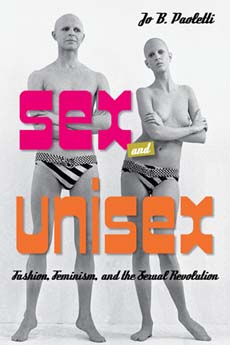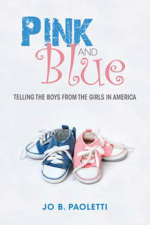As infants grow into toddlers, they become active participants in the gender binary fashion show, much to the amusement, chagrin or dismay of their parents. For boys and girls whose gender identity generally conforms to their biological sex, this participation appears likely to be enthusiastic embrace. These are the girls who insist on wearing nothing but pink and prefer dresses to any form of pants, and the boys who clamor for buzz-cuts and ubiquitous sports imagery. One of the most puzzling questions raised by the gendered clothing of the last generation is, “What about the others?” What about tomboys, the little girls who for decades could wear plain girls’ styles or their brother’s hand-me-downs without appearing out of the mainstream? (In a study of college age women in the early 1970s, 78% described themselves as “tomboys” as children, though the age to which they referred was unclear.) What about the one person in 100 classified as “intersex”, whose body differs from standard male or female and whose sense of identity may not conform to the gender chosen for them by their parents? What about boys who, like tomboys, feel more comfortable in the clothing of the other sex, but for whom the English language has no positive term? Certainly, one of the outcomes of a strong gender binary in children’s clothing is the lack of expressive options for children whose identities may be more fluid or contrary to stereotyped images of masculinity and femininity.
|
I just got a great email from commenter Andi, AKA "Feministjerk" (no, he really isn't!). He offered an expansion of his theory that the connection between pink and femininity is the result of post-World War II capitalism and branding. I think he's partially right, but one of the arguments I make in the book is that children themselves are actors in the process, and any theory that does not take children into consideration as consumers is going to be incomplete. The more adults have listened to -- and marketed to-- children, the more clothing for children under the age of six has become gendered. The typical 4-year-old is about the most ardent believer in gender stereotypes you can find, because that is where they are developmentally. Thus the princess craziness, for example. Disney knows 3-6 year-old girls.
As infants grow into toddlers, they become active participants in the gender binary fashion show, much to the amusement, chagrin or dismay of their parents. For boys and girls whose gender identity generally conforms to their biological sex, this participation appears likely to be enthusiastic embrace. These are the girls who insist on wearing nothing but pink and prefer dresses to any form of pants, and the boys who clamor for buzz-cuts and ubiquitous sports imagery. One of the most puzzling questions raised by the gendered clothing of the last generation is, “What about the others?” What about tomboys, the little girls who for decades could wear plain girls’ styles or their brother’s hand-me-downs without appearing out of the mainstream? (In a study of college age women in the early 1970s, 78% described themselves as “tomboys” as children, though the age to which they referred was unclear.) What about the one person in 100 classified as “intersex”, whose body differs from standard male or female and whose sense of identity may not conform to the gender chosen for them by their parents? What about boys who, like tomboys, feel more comfortable in the clothing of the other sex, but for whom the English language has no positive term? Certainly, one of the outcomes of a strong gender binary in children’s clothing is the lack of expressive options for children whose identities may be more fluid or contrary to stereotyped images of masculinity and femininity. Comments are closed.
|
Jo PaolettiProfessor Emerita Archives
January 2023
Categories
All
|


